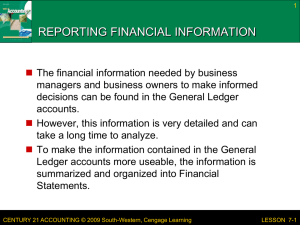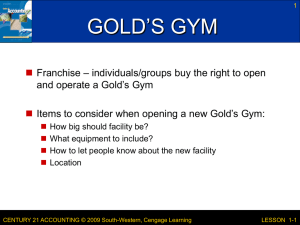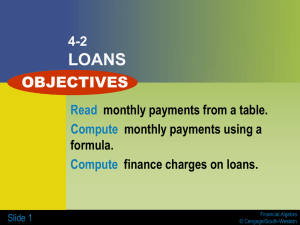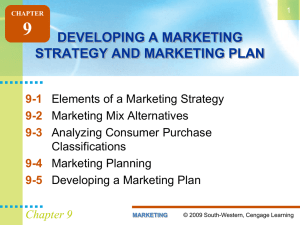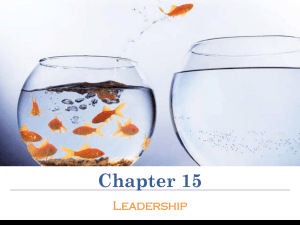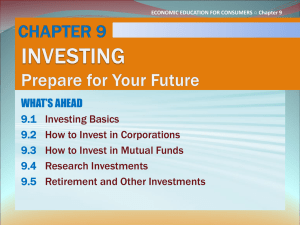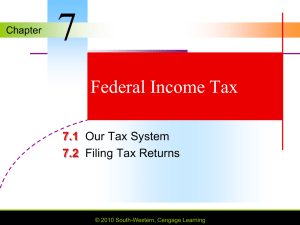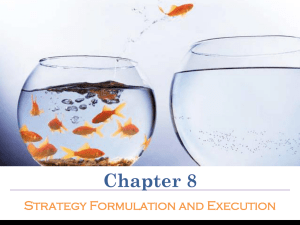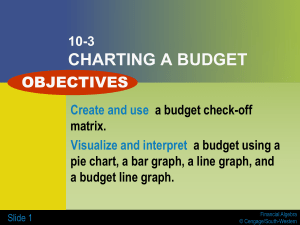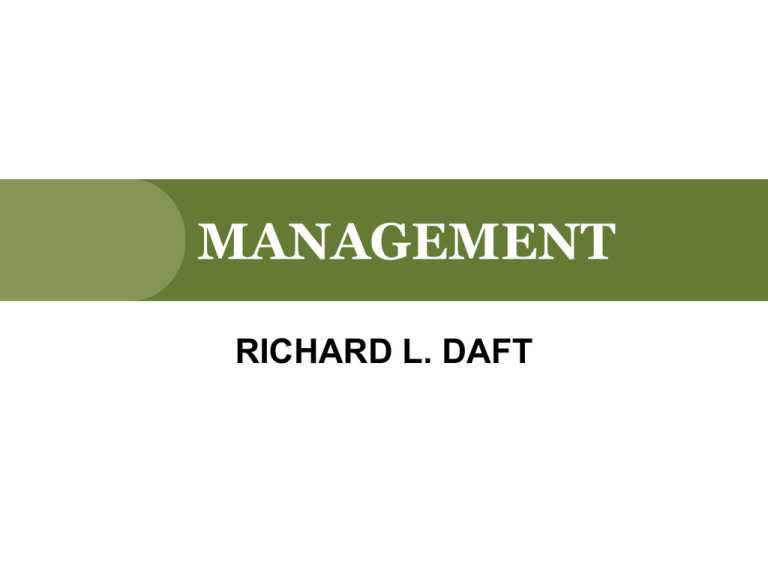
MANAGEMENT
RICHARD L. DAFT
Leading Teams
CHAPTER 19
chapter17
Learning Outcomes
• Identify the types of teams in organizations.
• Discuss some of the problems and challenges of teamwork.
• Identify roles within teams and the type of role you could play to help a
team be effective.
• Explain the general stages of team development.
• Identify ways in which team size and diversity of membership affects
team performance.
• Explain the concepts of team cohesiveness and team norms and their
relationship to team performance.
• Understand the causes of conflict within and among teams and how
to reduce conflict.
• Define the outcome of effective teams and how managers can
enhance team effectiveness.
3
Copyright ©2010 by South-Western, a division of Cengage
Learning. All rights reserved.
chapter17 How Do You Like To Work?
• Teams are a great way to gain
management experience
• Teams have become a primary way
organizations work
• Teams have advantages but they can be
challenging
• Good teams can be highly productive, but
teams aren’t always successful
4
Copyright ©2010 by South-Western, a division of Cengage
Learning. All rights reserved.
chapter17
Why Teams at Work?
• Individuals within organizations are
interdependent and teams are an effective
way to get work done
– A team is two or more people
– There is regular interaction
– Share performance goals
• Teams and groups are not the same….
5
Copyright ©2010 by South-Western, a division of Cengage
Learning. All rights reserved.
chapter17
Differences Between
Groups and Teams
6
Copyright ©2010 by South-Western, a division of Cengage
Learning. All rights reserved.
chapter17
The Dilemma of Teams
We have to give up our independence
We have to put up with free riders
Teams are sometimes dysfunctional
7
Copyright ©2010 by South-Western, a division of Cengage
Learning. All rights reserved.
chapter17
Five Common
Dysfunctions of Teams
8
Copyright ©2010 by South-Western, a division of Cengage
Learning. All rights reserved.
How to Make Teams
Effective
chapter17
Smooth teams don’t simply “happen”
• Teams must:
– Define Roles
– Establish Norms
– Set Goals
• To increase effectiveness:
– Productive Output
– Personal Satisfaction
– Capacity to Adapt and Learn
9
Copyright ©2010 by South-Western, a division of Cengage
Learning. All rights reserved.
chapter17
Effective Team Leadership
Rally people around a
compelling purpose
Share power
Admit ignorance
10
Copyright ©2010 by South-Western, a division of Cengage
Learning. All rights reserved.
chapter17
Work Team
Effectiveness Model
11
Copyright ©2010 by South-Western, a division of Cengage
Learning. All rights reserved.
chapter17
Types of Teams
Formal Teams are those created by the organization
Vertical Team
Self-Directed Teams
• Functional Team
• Command Team
Horizontal Team
• Problem-solving Team/Quality
Circles
– Permanent
• Cross-functional
Team/Task Force
• Committee
• Special-purpose
Teams/Project Teams
– Diverse skill set
– Access to resources
– Empowered to make decisions
12
Copyright ©2010 by South-Western, a division of Cengage
Learning. All rights reserved.
chapter17
Horizontal and Vertical
Teams in an Organization
13
Copyright ©2010 by South-Western, a division of Cengage
Learning. All rights reserved.
chapter17
Innovative Uses
of Teams
• Virtual Teams - geographically or
organizationally dispersed members who
are linked through technology
– Use technology to build relationships
– Shape culture through technology
– Monitor progress and reward members
14
Copyright ©2010 by South-Western, a division of Cengage
Learning. All rights reserved.
chapter17
What Effective Virtual
Team Leaders Do
15
Copyright ©2010 by South-Western, a division of Cengage
Learning. All rights reserved.
chapter17
Global Teams
• Cross-border Work Teams
– Members of different nationalities, countries,
cultures
– May be a virtual team
• Enormous Challenges
– Gaps of time, distance and culture
• Challenges can impact communications,
decision making, and work pace
16
Copyright ©2010 by South-Western, a division of Cengage
Learning. All rights reserved.
chapter17
Team Characteristics
• Size – additional members beyond five
can cause a decrease in motivation
– Need diverse skills but intimate
• Diversity – diverse teams produce more
innovative solutions to problems
• Member Roles – structure to focus on
tasks and social needs
17
Copyright ©2010 by South-Western, a division of Cengage
Learning. All rights reserved.
chapter17
Task Specialist Role
Successful teams are structured with clear team member roles
• Task Specialists
Role:
Initiate ideas
Encourage
Harmonize
Give opinions
Seek information
Energize
• Socioemotional Role:
Reduce Tension
Follow
Compromise
18
Copyright ©2010 by South-Western, a division of Cengage
Learning. All rights reserved.
chapter17
Stages of Team
Development
Forming
Storming
Norming
Performing
Adjourning
19
Copyright ©2010 by South-Western, a division of Cengage
Learning. All rights reserved.
chapter17
Team Cohesiveness
•
•
•
•
•
Determinants
Consequences
Team Interaction
Shared Goals
Personal Attraction to the Team
Presence of Competition
Team Success
• Morale
• Productivity
20
Copyright ©2010 by South-Western, a division of Cengage
Learning. All rights reserved.
chapter17
Four Ways Team
Norms Develop
21
Copyright ©2010 by South-Western, a division of Cengage
Learning. All rights reserved.
chapter17
Managing Team Conflict
• Antagonistic behavior that blocks the goals of
the team
• Conflict is inevitable, but it must be dealt with
• Several causes of conflict:
Competition over resources
Communication breakdowns
Trust
Differing goals
22
Copyright ©2010 by South-Western, a division of Cengage
Learning. All rights reserved.
chapter17
Balancing Conflict
and Cooperation
23
Copyright ©2010 by South-Western, a division of Cengage
Learning. All rights reserved.
A Model of Styles to
Handle Conflict
chapter17
Competing
Avoiding
Compromising
Accommodating
Collaborating
24
Copyright ©2010 by South-Western, a division of Cengage
Learning. All rights reserved.
chapter17
Managing Conflict
Superordinate goals – the ability for team
members to see the big picture and reach larger
objectives
Mediation – using a third party to settle disputes
Negotiation – Give and take discussions and
consideration of alternatives
• Intergrative negotiation – a win-win assumption
• Disruptive negotiation – each party attempts to gain
a fixed “size of the pie”
25
Copyright ©2010 by South-Western, a division of Cengage
Learning. All rights reserved.
chapter17
Rules for Reaching a
Win-Win Solution
Separate the people from the problem
Focus on interests, not current demands
Generate many alternatives for mutual
gain
Insist that results be based on objective
standards
26
Copyright ©2010 by South-Western, a division of Cengage
Learning. All rights reserved.
chapter17 Work Team Effectiveness
• Productive Output
• Does the team’s output meet expectations?
• Satisfaction of Members
• Does the experience contribute to the wellbeing, personal satisfaction and development
of members?
• Capacity to Adapt and Learn
• Has the team learned from experience?
27
Copyright ©2010 by South-Western, a division of Cengage
Learning. All rights reserved.


